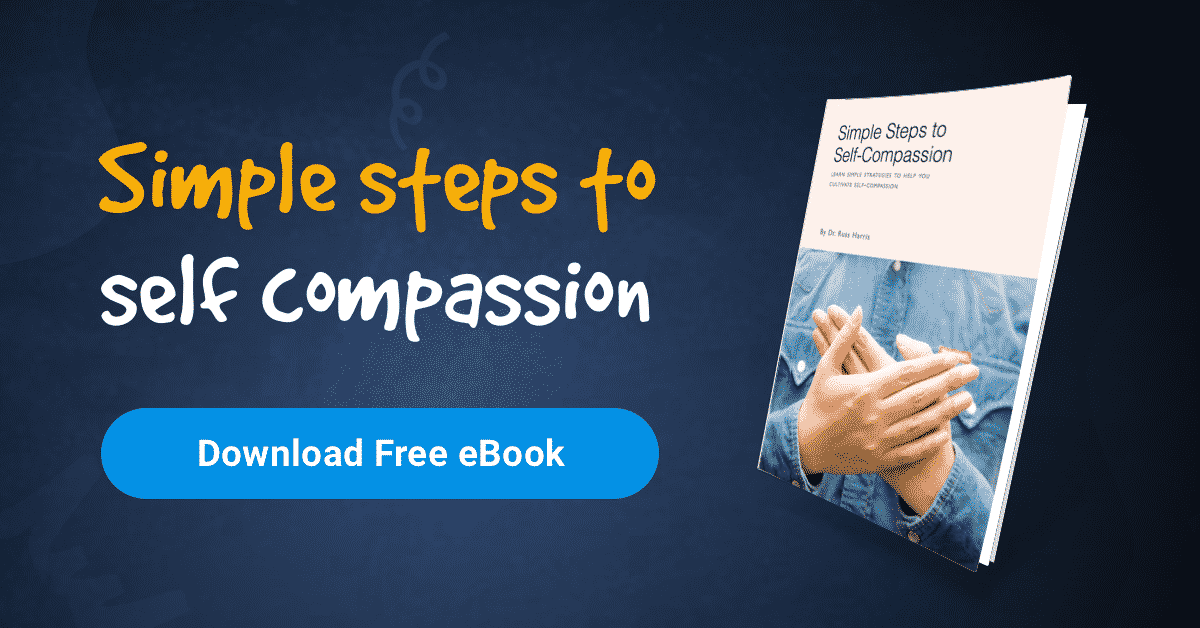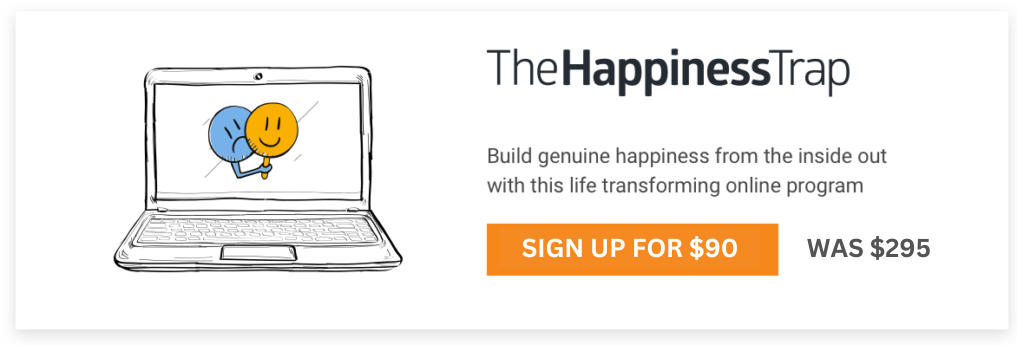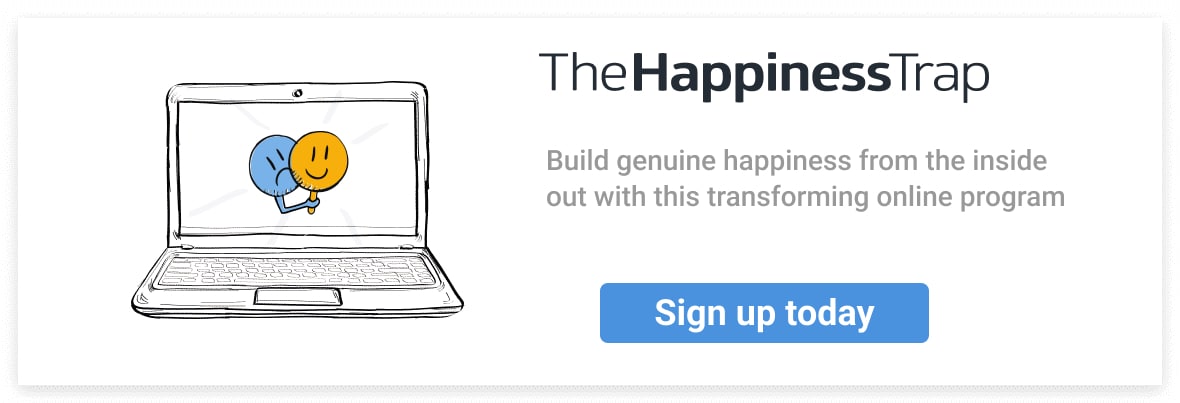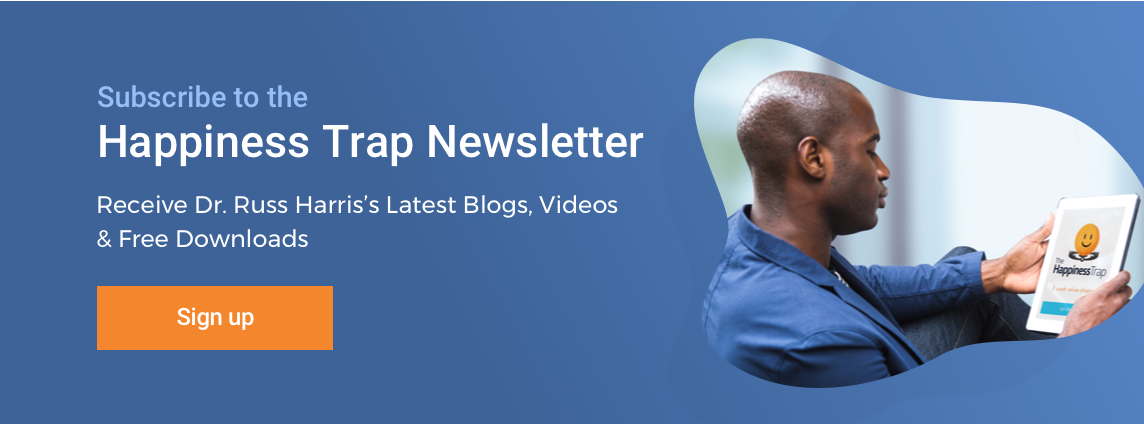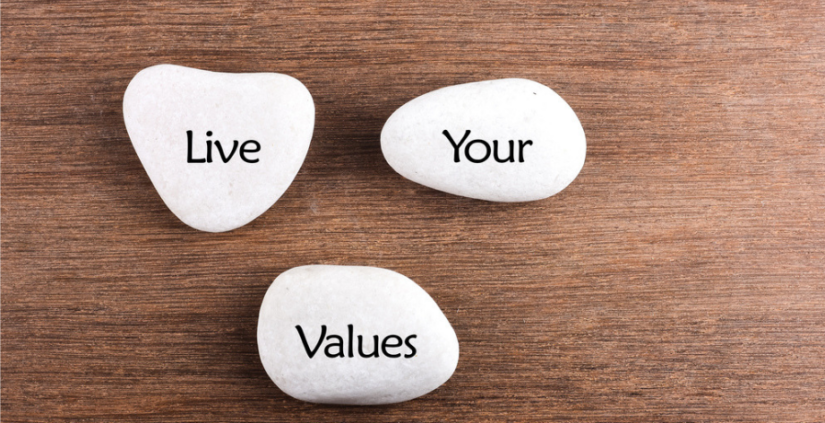

Will getting that great job or house really make you happier?
In this fun and entertaining video, Russ explains the important distinction between living a goals-focused vs a values-focused life and why living in accordance with your innermost values can lead to a more rich, full, and meaningful life.
Has your mind ever hooked you with this question: “I don’t know what to do with my life?”
Mine certainly has, and I can tell you: it’s a recipe for misery. The more you get hooked by this question, the more dissatisfied you become with the life you have.
The problem is, this question is sooooo big, almost nobody can answer it (except for the tiny number of people who have some sort of grand calling or vision for their whole life, which is almost always to do with religion or politics).
For most of us, this is not a useful question to ask; it’s just too big, too overwhelming. Here are some far more helpful questions to ask yourself:
What do I want to do with …
- My evening
- My weekends
- My summer holiday
- The rest of this week
- The rest of this day
- This hour
- This next 10 minutes
- My body – today, tomorrow, next week, next month, next year
- My job/work/career – today, tomorrow, next week, next month, next year
- My finances – today, tomorrow, next week, next month, next year
- My leisure time – today, tomorrow, next week, next month, next year
- My further education or skills development – today, tomorrow, next week, next month, next year
- My friends – today, tomorrow, next week, next month, next year
- My family – today, tomorrow, next week, next month, next year
- My hobbies – today, tomorrow, next week, next month, next year
- My volunteer work – today, tomorrow, next week, next month, next year
Don’t try to answer all these at once; that will also be overwhelming.
Pick one or two to focus on each week. Then, over a period of two or three months, gather your answers.
And come up with your own questions; the ones above are just examples that may or may not be relevant to you.
Make your questions specific, and explore what you want to do short term, medium term, and long term.
And if the answer to any question is “Don’t know” then until such time as you do know, why not make the best of what you are currently doing?
Engage in it fully, appreciate it, do it well, make the most of it.
The Happiness Trap Online Program
The Happiness Trap Online Program is based on an empirically-supported model known as Acceptance and Commitment Therapy (ACT).
Over a 35 year period, evidence has mounted for ACT’s effectiveness in treating conditions including anxiety, chronic pain, depression, stress, smoking, weight loss and performance enhancement.
The Happiness Trap program teaches highly-effective strategies and interventions based on the ACT model, which can help you stop struggling with difficult thoughts and feelings and build genuine and lasting happiness.
We often find ourselves in situations that we don’t want to be in or having to do things we don’t particularly like.
But what happens if we take the time to get in touch with our values; to clarify what sort of person we want to be and how we want to treat ourselves and others?
Once we know our values, we can ‘sprinkle’ them into our actions; use them to ‘flavour’ whatever we are saying and doing. And almost always when we do this, whatever we’re doing then becomes far more rewarding.
For example, consider the case of Rob, a 22-year-old university student.
While Rob was studying a five-year architecture course, he was working part-time as a waiter to help pay his way. He told me that he hated his job, but he needed the money to pay for his food and board.
He knew it was only temporary and that in one more year he’d be working as an architect, but that didn’t stop him from dreading every shift.
It wasn’t that he worked in a horrible place or had some terrible boss; he just didn’t like the work. The only other part-time work he could get was cleaning, stocking shelves, serving hamburgers or bartending, and these were, in his opinion, even worse.
I questioned him about his values and how he could use them to transform his relationship with his job.
He identified values such as mindfulness, caring, curiosity, openness warmth and humour. I then asked him what might happen if he engaged mindfully with the customers?
What difference might it make if he were to be fully present? To pay attention with openness and curiosity to the clothes they wore, the style of their hair, and the tone and rhythm of their voices? To notice the way that they ate and drank and spoke?
To notice their facial expressions and physical gestures? And what might happen if he was more caring about the customers: if he cared about their experience in the restaurant and the quality of his service?
Inspired by this way of thinking, Rob had an idea. He would become a ‘Zen master of pizza delivery’. He would connect mindfully with his body to ensure he had the best possible posture and carry that pizza as if it were a priceless work of art.
He would be more caring about how he lowered that pizza to the table; he’d lay it down as if placing it in front of a king. All the while, he would contribute warmth and good grace and he’d also share his excellent sense of humour.
And the result? Well, his work didn’t magically turn into some ‘dream job’, but it did become much more fulfilling.
He wasn’t ‘just waiting pizzas’ anymore; now he was contributing to people’s lives, challenging his body, engaging in the world, developing his mindfulness skills and having moments of fun along the way.
He was staggered by the difference it made. The dread disappeared and so did the boredom. There was still a huge difference between the job he ideally wanted and the one he had, but he had discovered the fulfilment of living by his values.
If there’s one thing that sucks the joy out of life, it’s going through your day trying to resolve some difficult dilemma. We’ve all, at times, had to grapple with really hard decisions and tough choices.
‘Do I stay in this relationship – or leave?’,
‘Do I quit this job – or do I stay?’,
‘Do I enrol in that course – or the other one?’,
‘Do I have the operation – or not?’,
‘Do we try to have children – or not?’, ‘
Do I buy this one – or the other one?’, ‘
Do I want to live here – or there?’
When we’re dealing with these dilemmas, our mind easily goes into overdrive, desperately trying to figure out what to do; to ‘make the right decision’.
The problem is, it can take days, weeks, months – or even years in some cases, such as unhappy marriages or unfulfilling jobs – before we finally choose one option over the other.
And, in the meantime, we can easily spend our days wandering around in a thick psychological smog – endlessly pondering: ‘Do I or don’t I?’ – and, in the process, we make ourselves anxious or stressed, and we miss out on life, here and now.
So, how can ACT help us?
Step 1: Acceptance
When my clients present their dilemmas, hard decisions or tough choices I start off by telling them,
‘You probably will not make your final decision during our session today. It could happen – but it’s extremely unlikely.’
And if you are facing a major dilemma or decision in your life today, this is almost certainly true for you; you are not likely to resolve it in the next 24 hours. Can you make room for this reality? Struggling with it will only make it worse.
Step 2: Common Sense Steps: Costs & Benefits & More Information
Sometimes a dilemma can be resolved by the age-old common-sense method of a ‘cost-benefit analysis’. In other words, write down a list of all the benefits and all the costs for each option.
If you’ve already done this and it hasn’t helped, fair enough – at least you tried. But if you haven’t done this – or if you’ve done it half-heartedly – or you’ve done it in your head but not on paper – then you should definitely give it a go.
When you write it all down in black and white, that is a very different experience than thinking it through inside you head or talking it through with a friend – and it may help you finalise your decision.
Keep in mind that sometimes the issue can be resolved by finding out more information from a reliable source (a book, a person, a website, an organization, etc.) So make sure you have gathered enough information to make an informed decision.
If you are lucky, this new information will make the costs and benefits of each option clearer, and help you decide what to do.
However, the inconvenient truth is this: the greater the dilemma, the tougher the decision, the less likely these ‘common sense’ methods are to be helpful. Why? Because if one option was obviously far better than the other, then you wouldn’t have a dilemma in the first place!
Step 3: No Perfect Solution
Next, recognise there is no perfect solution, so whichever choice you make, you are likely to feel anxious about it – and your mind is likely to tell you,
‘That’s the wrong decision’, then point out all the reasons why you shouldn’t do it.
If you’re waiting until the day there’s no feelings of anxiety, and no thoughts about making the wrong decision, you’ll probably be waiting forever.
Step 4: There’s No Way Not To Choose
Recognise that whatever your dilemma is, you’re already making a choice. Each day you don’t quit your job, you are choosing to stay (until the day you hand in your resignation, you are staying in that job.)
Each day that you don’t leave your marriage, you are choosing to stay (until the day you pack your bags and move out of the house, you are staying in that marriage.)
Each day that you don’t sign the consent form for the operation, you are choosing not to have surgery, and so on.
Step 5: Acknowledge Today’s Choice
Following on from the above, kick off each day by acknowledging the choice you are making for this day.
For example, say to yourself,
‘Okay, for the next 24 hours, I choose to stay in the marriage’ or ‘For the next 24 hours, I choose to keep using contraceptives.’
If 24 hours seems too long, then make a choice for the next 12 hours, or 6 hours, or even for the next sixty minutes.
At the end of that time period, reassess and make another choice – for the next 24 or 12 or 6 hours (or even sixty minutes).
Step 6: Take A Stand
Given your choice in step 5 above, what do you want to stand for in the next 24, 12 or 6 hours (or even sixty minutes)?
What values do you want to live by, in this area of life? If you’re staying in the marriage for another day or another hour, what sort of partner do you want to be for that one day or hour?
If you’re staying in your job for another day or another hour, what sort of employee do you want to be for that one day or hour?
Step 7: Make Time To Reflect
Put aside time on a regular basis to mindfully reflect on the situation. The best way to do this is as in step 2: using a diary or a computer, write down the costs and benefits of each option, and see if anything has changed since last time you did this.
You could also try to imagine what life might be like – both the positives and the negatives –
a) if you went down one path, and
b) if you went down the other path.
For most people, ten to fifteen minutes 3 or 4 times a week is more than enough reflection time – but you can put aside as little or as much as you like.
The key thing is, make it focused, in other words, don’t try to do it at the same time as watching TV or doing housework or driving home or going to the gym or cooking dinner. Just sit quietly with your pen and paper or a computer, and do nothing else but reflect, as above, for the allotted time.
Step 8: Name The Story
Throughout the day, your mind will try to pull you back into the dilemma, over and over again. But if this was truly helpful, you’d already have resolved your dilemma, wouldn’t you?
So practice ‘naming the story’. For example, try saying to yourself, ‘Aha! Here it is again. The “stay or leave” story.
Thanks mind. I know you’re trying to help, and it’s okay – I’ve got this covered.’
Then focus your attention on doing some meaningful, values-guided activity. You will probably find it helpful to remind yourself, ‘I’ll think about this later, in my scheduled reflection time’.
Step 9: Open Up & Make Room
Feelings of anxiety will almost certainly arise – again and again and again – whichever option you choose. So practice opening up & making room for those feelings.
Acknowledge to yourself, ‘Here’s anxiety.’ Remind yourself, ‘This is normal.
It’s what everybody feels in a challenging situation with an uncertain outcome.’
Step 10: Self-compassion
Last, but not least, be compassionate to yourself. Treat yourself gently. Talk to yourself kindly. Unhook yourself from all that unhelpful, self-judgmental mind-chatter, using whatever defusion techniques you find best – e.g. thanking your mind, naming the story etc.
Remind yourself that you’re a fallible human being, not some high-tech computer that can coldly analyse the probabilities and spit out an answer.
Remind yourself that this is a very difficult decision – if it were easy, you wouldn’t have a dilemma in the first place! Acknowledge that you’re in pain, you’re hurting.
And do plenty of kind, caring, nurturing, considerate things for yourself; things that soothe, or nurture, or support you in this time of hardship.
This could include anything from spending quality time with close friends, taking care of your body, treating yourself to a favourite leisure activity, making time for yourself to pursue a sport or creative outlet, or even cooking a healthy dinner. It’s often helpful to practice some form of self-compassion practice.
Recycle through these steps every day, or several times a day. And one of three things will happen:
1) Over time, one option becomes obviously more attractive than the other.
2) Over time, one option disappears, it’s no longer available.
3) Over time, your dilemma remains unsolved.
If either 1 or 2 happens, the decision is made, there is no dilemma any more.
If 3 happens, then at least you get to go through each day mindfully living by your values, instead of being lost in a smog of anxious indecision.
Plus, you’ll get plenty of practice at developing self-compassion.
It’s a lot easier to start some new type of life-enhancing behaviour than it is to keep it going.
How can we sustain new patterns of behaviour, until we’ve done them for so long they become habitual?
And for those of us who are therapists, coaches, or other types of health professionals: how can we help our clients to keep up new behaviour between sessions?
Well, there are hundreds, if not thousands of tools out there to help us with this challenge, but we can pretty much bundle them all into what I like to call ‘The Seven Rs’: Reminders, Records, Rewards, Routines, Relationships, Reflecting, and Restructuring.
Now let’s take a look at each one individually.
1) Reminders
We can create all sorts of simple tools to help remind us of the new behaviour we wish to persist with.
For example, we might create a pop-up or a screen saver on our computer or mobile phone with an important word or phrase or symbol that reminds us to act mindfully or to utilise a particular value.
We might use the old favourite of writing a message on a post-it and sticking it on the fridge or propping it against the bathroom mirror or taping it to the car dashboard. Or we might write something in a diary or calendar or in the ‘notes’ app of a smartphone.
We might write just one word, like ‘breathe’ or ‘pause’ or ‘patience’, or we might use an acronym like ‘A.C.T’ or ‘S.T.O.P’, or a phrase like ‘letting go’ or ‘caring and compassionate’.
Alternatively we might put a brightly-coloured sticker on the strap of our wristwatch or the back of our smartphone or the keyboard of our computer, so that every time we use these devices, the sticker reminds us to do the new behaviour.
2) Records
We can keep a record of our behaviour throughout the day, noting down when and where we do the new behaviour, what the benefits are, when and where we do the old behaviour, and what the costs are.
Any diary or notebook – on paper, or on a computer screen – can serve this purpose.
3) Rewards
When we do some form of new behaviour that involves mindfully acting on our values, hopefully that will be rewarding in its own right. However, we can help to reinforce the new behaviour with additional rewards.
One form of reward is kind, encouraging self-talk, e.g. saying to yourself: ‘Well done. You did it!’ Another form of reward is sharing your success and progress with a loved one who you know will respond positively.
On the other hand, you might prefer more material rewards. For example, if you sustain this new behaviour for a whole week, you buy or do something that you really like – get a massage, for example.
4) Routines
If you get up every morning at the same time to meditate or exercise or do yoga, over time that regular routine will become habitual.
It will require less ‘willpower’ and it will become a part of your regular routine. So experiment: see if you can find some way to build a regular routine or ritual around your new behaviour, so it starts to become part of your way of life.
For example, if you drive home from work, then every night, just before you get out of your car, you might do two minutes of mindful breathing, and reflect on what values you want to live by when you walk through the front door into your home.
5) Relationships
It’s easier to study if you have a ‘study-buddy’, it’s easier to exercise if you have an ‘exercise-buddy’.
In AA programs, they team you up with a sponsor who is there to help you stay sober when the going gets tough. So can you find a kind, caring, encouraging person who can help support you with your new behaviour?
Maybe you can check in with this person on a regular basis and tell them how well you are doing, as mentioned in ‘Rewards’. Or maybe you can email your support person the ‘Records’ you’ve been keeping.
Or maybe you can use the other person as a ‘Reminder’ – ask them to remind you to do the new behaviour, if and when that would be useful. For example, you might say to your partner,
“When you see me worrying, can you please remind me to do some mindful breathing?”
6) Reflecting
Regularly take time to reflect on how you are behaving, and what effect it is having on your life. You can do this via writing it down – ‘Records’ – or in discussion with another person – ‘Relationships’.
Or you can do this as a mental exercise throughout the day, or just before you go to bed, or just as you’re waking up in the morning.
You simply take a few moments to reflect on questions such as:
1) How am I going?
2) What am I doing that’s working?
3) What am I doing that’s not working?
4) What can I do more of, or less of, or differently?
Make sure you also reflect on the times that you STOP doing the new behaviour, and fall back into the old one.
Notice what triggers those relapses and setbacks, and notice what it costs you – i.e. how do you suffer when that happens?
This doesn’t mean beat yourself up! This means non-judgmentally reflecting on the genuine costs to your health and wellbeing caused by falling back into old habits.
Then use your awareness of the suffering this causes you, to help motivate yourself to get back on track.
7) Restructuring
We can often restructure our environment to make our new behaviour easier, and therefore more sustainable.
For example, if the new behaviour is ‘healthy eating’ we can restructure the kitchen to make healthy eating easier.
We can get rid of, or hide away, the junk food, and stock the fridge and pantry with healthy stuff.
If we want to go to the gym in the morning, we could pack up our sports-gear in our gym-bag, and place it by the side of the bed or somewhere else obvious and convenient, so it’s all ready to go as soon as we get up.
So there you have it – ‘The Seven Rs’: Reminders, Records, Rewards, Routines, Relationships, Reflection, and Restructuring.
Now be creative! Mix and match these methods to your heart’s content to create your own set of tools for lasting change. Good luck with it!
In part 1 we explored some of the problems with our very natural tendency to want to ‘be right’. Let’s now have a look at what we can do about this.
If we want to change any self-defeating behaviour, a great first step is to increase self-awareness. We want to notice when and where we are clinging to ‘I’m right’, and notice what effects that has on our behaviour – usually it leads us to speak in ways that are unkind, harsh, judgmental, critical, arrogant, egotistical, or aggressive.
And we also need to notice what effects it has on our relationships. Not surprisingly, it almost always makes them worse because no one likes to be spoken to in such a manner. And we need to keep in the back of our mind this question: ‘Would I prefer to be right or to be kind?’
If we wish to build healthy relationships with other people, where they feel cared for, respected, and well-treated, then the answer is obvious.
Being kind trumps being right. Even if we are right, and the other person is wrong, it is rarely helpful to point it out. And on those rare occasions where it is useful to point it out, it is so much better to do so with kindness, caring and respect, than with arrogance, condescension, or righteousness. After all, when you screw up or do something wrong, how would you prefer to be spoken to?
So, how can you tell if you’re too caught up in ‘being right’? Well, indicators may include: A lot of judging and criticising others, feeling superior or looking down on others, intolerance, condescension, smugness, refusing to back down, apologise, or admit that you made a mistake, continuing arguments on and on, long after they have become pointless, justifying your position continually (either to others or inside your own head), or loved ones saying things to you like, “Okay. You’re right and I’m wrong, yet again!”
So, if you think this issue applies to you (and I suspect it applies to some extent to almost everyone – it’s certainly something I struggle with!) then as soon as you realise you’ve been hooked by the ‘I’m right’ story – pause.
Pause and take a long breath. Then silently label what is happening inside your head: “Aha! Here I am trying to be right!” or “Aha! Here’s the ‘I’m right’ story again.” Or more simply just label it, ‘Being Right’.
Then pause a bit more and remember the question: ‘Would I prefer to be right or be kind?’ And finally, go to that kind place in our hearts and find a way to speak with warmth, kindness and respect, instead of righteousness.
Then notice what happens over time. You’re sure to see your relationships improve – and surely that’s better than being right. Right?
“There are two cardinal sins: Looking good and being right”.
I love this quote from my mentor, Steve Hayes. In a later blog we’ll cover ‘looking good’ but for now, we’re going to focus on ‘being right’.
‘What’s the problem with being right?’ you might be wondering. Good question. And the answer is… it depends.
It depends on the situation. In many situations, being right is not a problem at all. For example, if a doctor is right in his diagnosis and treatment of your illness, that’s great! But in other situations, being right can be very destructive.
For example, consider what happens in our relationships with loved ones when we are convinced that we are right.
If I insist that, ‘I’m right’, and then by default, ‘you are wrong!’ And how does it feel to be wrong? Not good.
When we believe we are ‘in the wrong’, we may feel guilty, sorry, ashamed, anxious, regretful, dumb, stupid, inadequate, incompetent, and so on.
And how does it feel to be right? We feel powerful, strong, righteous, correct. We feel totally justified, infallible, superior. Much better than being wrong.
‘I’m right, you’re wrong’ takes many different forms. It might be, ‘Here, give it to me. You don’t know how to do it!’ or ‘See! Look what happened! I told you!’ or ‘You know you’re not very good at this. Let me handle it.’ Or ‘I’m driving!’ or ‘Wrong!’ or ‘You’ve done it again!’ or ‘No!!!’ or ‘Why do you always do that?’ or ‘Why do you never listen to me?’ or even, ‘See? I was right!’
There are at least eleven thousand, two hundred and sixty three different ways of communicating, ‘I’m right, you’re wrong’ from rolling eyeballs to frowning to tut-ting to numerous variations on the phrases above.
And if we’re honest with ourselves, we do quite like to be right. Why? Because it makes us feel strong, smart, powerful, superior, or something similar. But unfortunately, it makes the other person feel weak, dumb powerless, inferior or something equally unpleasant. And that is not good for our relationships.
So what can we do about it? We’ll cover that in part 2.

